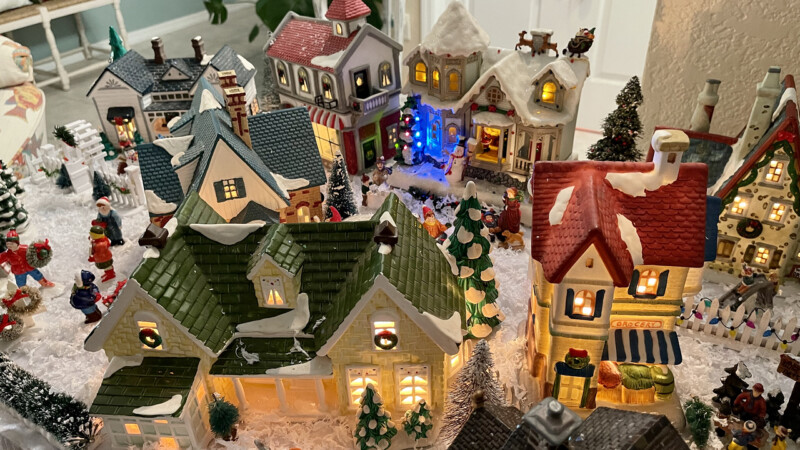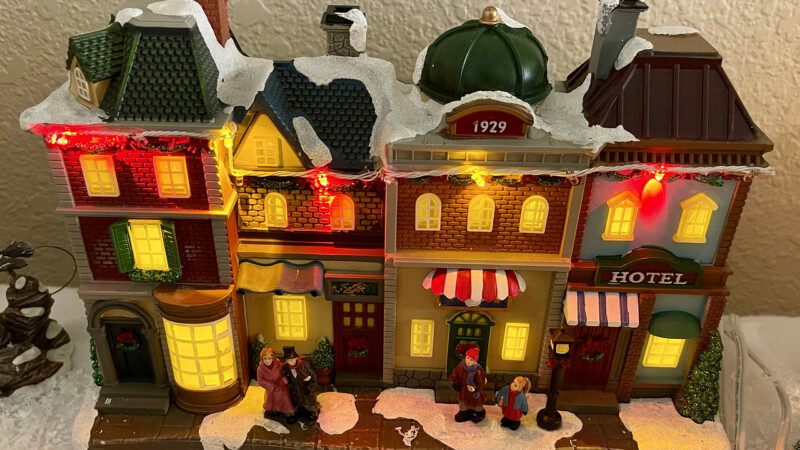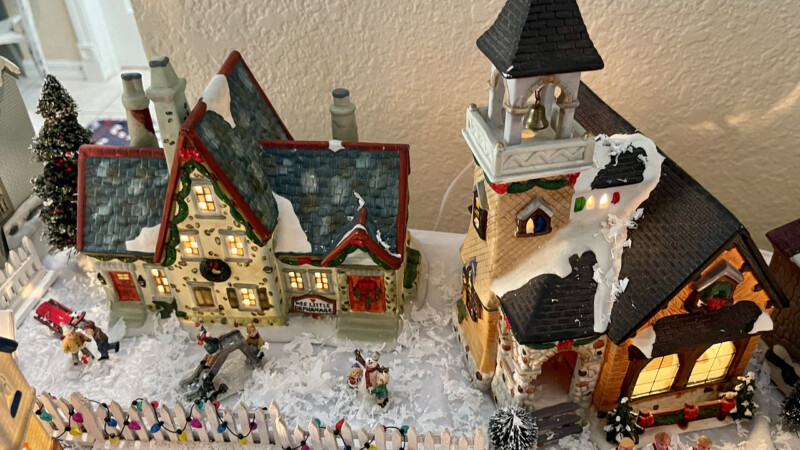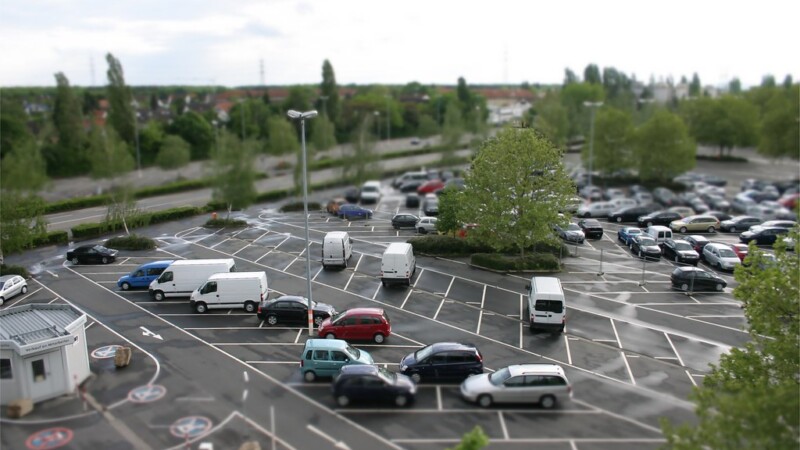
You may think your miniature Christmas Village is a quaint tribute to the building traditions of yesteryear. However, its walkable, mixed-use, architecturally diverse layout is a flagrant violation of modern zoning laws and an affront to the single-family development ascendancy.
Christmas villages are popular seasonal displays in no small part because they have the qualities that make real neighborhoods and towns attractive: They’re dense, vibrant and so packed with ceramic Christmas paraphernalia that they’re generally devoid of parking craters and dead space. The Christmas Village assembled annually by Colleen Healy Heaverly of Punta Gorda, Florida, is no exception.
However, these very qualities contradict the real-life land use and building patterns dictated by modern code and zoning laws in many communities. Since the 1950s, local governments have embraced Euclidean zoning, also known as exclusionary zoning, which separates land use by type — commercial uses can only exist in commercial zones, separated from residential zones, etc. And unfortunately for this Christmas Village, it falls squarely into a low-density residential zone designated exclusively for single-family housing. As such, it must face the wrath of that most Grinchlike of city departments: municipal code compliance.


Let’s start with the Christmas Village grocery store. With its location in a residential neighborhood just steps from several houses, many people would find this charming shop a perfect fit. Those people would be dead wrong, according to current zoning practices. Neighborhood shops are common in older neighborhoods and continue making them attractive places to live, but under modern zoning, they are forbidden from most residential zones. I’m sorry, but this grocery store will have to relocate 10 minutes away to a commercial zone, preferably in a strip mall surrounded by a surface parking lot. Nothing says Christmas spirit like a strip mall on a suburban arterial highway.

What’s this? Townhomes? Totally unacceptable. Townhomes are one of several kinds of missing middle housing, or multi-unit housing types ranging in scale between the two most common forms of housing today: single-family homes and large-scale apartment buildings. Townhomes and other missing middle options like duplexes, bungalow courts, shotgun houses and others were common in American neighborhoods before exclusionary zoning became ubiquitous. They provide a variety of housing options to meet local needs and to create walkable neighborhoods with amenities near residents’ homes.
So obviously, they cannot be allowed to exist. Townhomes are OK if they’re in a big sprawling complex of only other townhomes and nothing else. But mixed in with other types of housing? I think not! The last thing we want is Christmas villagers seeing this and thinking there should be more choices in housing. Over in the Christmas gated subdivision, you get plenty of choices already. You can choose to have your garage to the right or the left, and you can pick your paint color from a wide selection of three shades of beige.
Now, of course we can’t tell the owners of these townhomes they all should be demolished. Just demolishing every other one should do.

This one’s just an average sailmaker like you find in every neighborhood, and it looks OK at first. But wait, what’s that separate structure on the roof with its own entrance? I know an ADU when I see one!
ADUs, or accessory dwelling units, are smaller secondary residences that share a property with a main house; other examples include garage apartments, detached mother-in-law suites and attic or basement apartments. These are another form of missing middle housing that advocates say adds new housing units that are typically less expensive than a single-family home in the same area, helping renters and property owners alike.
But that misses the point. Providing an affordable home for some impecunious young renter or your Meemaw just isn’t fair to richer residents. If they had to pay $450,000 for their home, it’s only right that everybody else pay at least that much. I move that we evict the tenant and require the sailmaker to demolish the offending ADU at their expense. We’ve got property rights to worry about.


A Christmas shop and a Books & Charts store with residences above them? These can only be live-work units, those unholy chimeras of smart planning that allow a resident to live and operate a business in the same building. Combining missing middle housing with mixed-use development, they fill the hearts of exclusionary zoning advocates with dread. It’s bad enough to find shops within walking distance of residences, but to find them in the same building? Insanity! The owners will have to pick: it’s either all shop, or all house. In the code of ordinances, zoning section, there can be no compromise.


This soup stand is in flagrant violation of ordinances covering signs and outdoor display structures. It far exceeds the limits of the sign area computation governing how large promotional signage can be. While I’m at it, the signs for that Yuengling brewery and the lobster hut back there are also pretty suspect; this all has to come down. And Chestnuts wagon, I’ve got my eye on you.

Hmm, a working farm immediately next to a residential neighborhood. What is this, the Middle Ages? Or pretty much any period of time before the 1950s? I know farms are important for, like, food or whatever, but can’t they be farther away?
At second look, it appears the farmland is under review to be rezoned from agriculture to low-residency residential and will soon be razed for a bunch of suburban tract homes and confusing streets. Some things resolve themselves.

This church doesn’t have nearly enough parking. According to the planning office, it has a seating capacity of 300, so by our parking rubric, they’ll need at least 150 parking spots. It doesn’t matter that only 45 people come on Sundays, or that many of them are families that come in the same car. On Christmas the church may hit capacity, meaning that for an hour a year, parking could be somewhat constrained in the adjacent blocks. To reach the 150-car minimum, I recommend demolishing the rest of the block for surface parking. Who’s going to miss the bookstore?

Here’s another church with insufficient parking. Fortunately, this one has the Wee Little Orphanage next door, which can easily be razed for the lot. Come on, people, you really should be thinking about what’s good for the community.

Well, the school doesn’t seem to be violating any zoning ordinances, but it’s definitely not ideal. Located in the middle of the community, connected to the residential district by safe, pedestrian-friendly streets, it’s an abomination. The last thing we want is kids walking to school, slightly delaying drivers and taking up valuable space that could go to cars. A proper school would be a sprawling one-story building separated from everything else by a vast sea of surface parking and grass lots that aren’t used for recess or sports. Still, I’m not seeing a violation — wait, what’s this?

Sailor’s Pub is near the school? Florida law dictates that bars can’t be located within 500 feet of a school, and this is, what, a foot and a half? With a bar that close, children could easily get on each other’s shoulders, put on a hat and trenchcoat, and walk right into a den of nautical vice where they’d be exposed to demon rum, and probably even Bacardi rum, Captain Morgan and all the other ones!
Never mind that schools in older towns and neighborhoods are close to all sorts of things and don’t have a higher rate of two-kids-in-a-trenchcoat-related delinquency. We’re not here to solve problems, we’re here to tell people what they can and can’t do, and you can’t have a bar near a school. One will have to be demolished, probably the school. Got to protect our kids!

The sustainable working waterfront is the backbone of Christmas village’s economy, but developers have been pressuring the local government to shut down the docks and rezone the property for residential or commercial uses. I for one agree that the highest and best use of the waterfront is some condos, or barring that, 10 McMansions. Sure, public access would be permanently cut off, with severe consequences for the economy, but that’s a small price to pay for a couple of rich people to have a nice view.
Well, that completes our review of Christmas village’s myriad zoning violations. Let’s have a look at what it’ll look like once it follows all the proper ordinances:

So beautiful. Truly a Christmas miracle!







